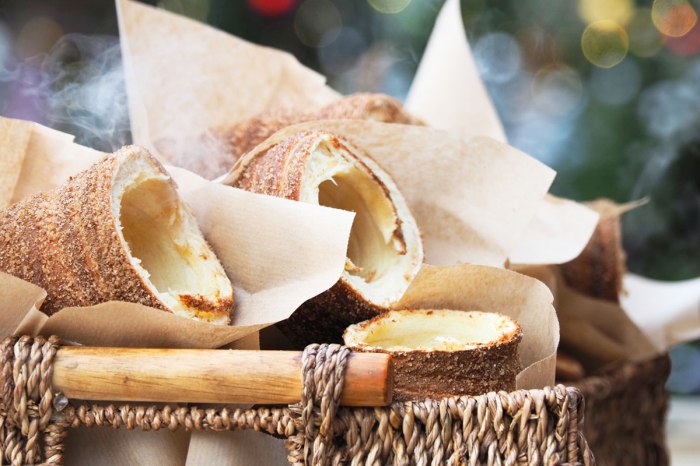Introduction to Chimney Cakes: House Of Chimney Cakes Nutrition Facts
House of chimney cakes nutrition facts – Chimney cakes, also known as kürtőskalács in Hungarian, are a delightful treat with a rich history and a surprisingly diverse range of flavors and preparations. These sweet, cylindrical pastries are a beloved snack across Central Europe, boasting a unique texture and a customizable flavor profile that has made them a global phenomenon.The origins of the chimney cake can be traced back centuries to Transylvania, a region historically rich in diverse culinary traditions.
While the exact date of its creation remains shrouded in mystery, evidence suggests that variations of the pastry existed for centuries, with its current form solidifying over time. Initially baked over open fires using simple dough and sugar, the cake’s unique shape and crispy exterior quickly gained popularity, spreading across neighboring countries and evolving with each region’s unique culinary preferences.Traditional chimney cakes are prepared by wrapping a long strip of sweet yeast dough around a cylindrical wooden rolling pin.
This is then carefully rotated over an open fire or special electric roller, allowing the dough to cook evenly and develop its characteristic hollow, chimney-like structure. The consistent rotation ensures the dough cooks completely, resulting in a crispy exterior and a soft, slightly chewy interior. Once cooked, the warm cake is often coated in melted butter, sugar, and various spices or toppings, creating a truly irresistible treat.
Traditional Preparation Methods
The heart of the chimney cake lies in its preparation. The process begins with a simple, yet crucial, yeast dough. This dough, often containing flour, yeast, sugar, and eggs, is carefully kneaded to achieve the perfect consistency. The key is to obtain a dough that is both pliable and strong enough to withstand the intense heat of the open fire without tearing or breaking.
After the dough has risen, it is then carefully rolled into a long, thin strip, which is subsequently wrapped tightly around the cylindrical roller. This process requires skill and precision, ensuring the dough is evenly distributed to create the signature hollow center. The continuous rotation over the heat source is vital, ensuring even cooking and the development of the signature crisp exterior.
Common Variations and Regional Differences
While the basic chimney cake recipe remains consistent, regional variations abound, reflecting the diverse culinary traditions of Central Europe. In Hungary, the classic kürtőskalács is often coated with granulated sugar and cinnamon, creating a warm, comforting flavor. However, variations include coatings of melted chocolate, chopped nuts, coconut flakes, or even sweetened condensed milk. In some regions, the dough itself is flavored with vanilla, cardamom, or other spices, adding another layer of complexity to the already delightful pastry.
The toppings and flavors can change drastically depending on location and seasonality, offering a diverse range of experiences for the adventurous palate. For example, Slovakia might feature a nut-heavy topping, while Czech Republic could offer a unique combination of cinnamon and poppy seeds. These regional differences showcase the adaptability and enduring appeal of the chimney cake, making it a truly unique and diverse culinary experience.
Let’s face it, understanding the nutritional breakdown of our favorite treats is crucial for mindful eating. While we’re exploring the house of chimney cakes nutrition facts, remember that similar baked goods often share nutritional similarities. For instance, consider comparing the carbohydrate content to that found in flour tortilla nutrition facts , a common base for many dishes.
This comparison can provide valuable context when assessing the overall nutritional profile of your house of chimney cakes and making informed choices about your diet. Remember, knowledge is power!
Health Considerations and Dietary Implications

Chimney cakes, while undeniably delicious, aren’t a health food in the strictest sense. Their high sugar and fat content means they should be enjoyed in moderation as part of a balanced diet. Understanding their nutritional profile and how they fit into different dietary lifestyles is key to savoring them responsibly.Chimney cakes are essentially deep-fried dough, leading to a relatively high calorie and fat content per serving.
The addition of sugar, cinnamon, or other sweet toppings further increases the sugar and calorie count. However, the base dough itself is often made with simple ingredients like flour, yeast, and water, making them adaptable to various dietary needs.
Nutritional Value and Potential Health Drawbacks
The primary concern with chimney cakes is their high caloric density. A single, average-sized chimney cake can easily contain 300-500 calories, depending on size and toppings. This high calorie count, combined with the often high levels of saturated fat and sugar, can contribute to weight gain if consumed frequently and in large portions. Furthermore, excessive sugar intake is linked to various health problems, including type 2 diabetes and heart disease.
Therefore, mindful consumption is crucial.
Chimney Cakes and Dietary Plans
Chimney cakes, in their basic form, are naturally vegetarian. The dough typically contains only flour, water, yeast, and sometimes eggs. However, many variations include butter or other animal products in the dough or toppings. Adapting chimney cakes to a vegan diet is possible by substituting the eggs and butter with plant-based alternatives. For example, applesauce or mashed banana can replace eggs, while vegan butter or oil can replace dairy butter.
The toppings are also easily customizable; opting for fresh fruit, nuts, or sugar-free alternatives can create a healthier vegan version.
Mindful Consumption and Portion Control, House of chimney cakes nutrition facts
To manage calorie intake and enjoy chimney cakes responsibly, portion control is key. Instead of consuming a large chimney cake in one sitting, consider sharing one with a friend or opting for a smaller size. Choosing toppings wisely can also significantly impact the overall nutritional value. Opting for fresh fruit, a light dusting of cinnamon, or a small amount of nut butter over excessive sugar or chocolate can reduce the sugar and fat content.
Furthermore, integrating chimney cakes into a balanced diet with plenty of fruits, vegetables, and lean protein helps to mitigate the potential negative health impacts.
Serving Suggestions for Healthy Consumption
The following infographic visually depicts recommended portion sizes and serving suggestions for healthy chimney cake consumption:
Infographic Description: The infographic is divided into three sections. The first section shows a large chimney cake, labeled “Typical Serving (High Calories).” The second section shows a half-sized chimney cake, labeled “Recommended Serving (Moderate Calories).” The third section shows a small, quarter-sized chimney cake alongside a small bowl of fresh berries and a sprinkle of cinnamon, labeled “Healthy Portion (Lower Calories).” Each section includes a simple calorie estimate (e.g., 500 calories, 250 calories, 125 calories) to emphasize the impact of portion size.
The overall message is to encourage smaller portions and healthier topping choices.
Comparative Analysis with Similar Treats

Chimney cakes, while undeniably delicious, aren’t the only game in town when it comes to sweet treats. Understanding how their nutritional profile stacks up against other popular choices is crucial for making informed dietary decisions. This comparison will highlight the differences in calorie density and macronutrient ratios, offering a clearer picture of chimney cakes’ place within a balanced diet.Let’s delve into a comparative analysis of chimney cakes against similar sweet treats, focusing on calorie density and macronutrient composition to provide a comprehensive understanding of their nutritional value.
This will help you make informed choices about incorporating chimney cakes into your diet.
Calorie Density and Macronutrient Comparison
A typical serving of chimney cake (approximately 100g) can range from 300-500 calories, depending on size and ingredients. This calorie count is significantly higher than some other popular treats but lower than others. For instance, a similar-sized serving of a rich, buttery croissant might exceed 400 calories, while a standard chocolate chip cookie (around 30g) could contain 150-200 calories. However, a single donut can easily surpass 250 calories, even without excessive toppings.
The macronutrient ratios also vary considerably. Chimney cakes tend to be higher in carbohydrates, reflecting their dough-based nature, while pastries often boast a higher fat content. Cookies usually fall somewhere in between, depending on their ingredients.
Healthier Alternatives and Nutritional Comparisons
Choosing healthier alternatives isn’t about deprivation, but about mindful selection. Several treats offer comparable satisfaction with a more favorable nutritional profile.
The following examples illustrate the nutritional differences between chimney cakes and healthier alternatives. These values are approximate and can vary based on specific brands and recipes.
- Apple slices with cinnamon and a sprinkle of nuts: A much lower calorie option, providing natural sweetness and fiber. A serving of about 1 medium apple with 1 teaspoon of cinnamon and 10g of almonds would contain approximately 150 calories, significantly less than a chimney cake, and offer a substantial fiber boost.
- Fruit salad with a dollop of Greek yogurt: A refreshing and naturally sweet alternative, rich in vitamins and antioxidants. A serving of approximately 200g of mixed fruit with 50g of plain Greek yogurt would contain approximately 200-250 calories and offer a good source of protein.
- Whole-wheat muffin with berries: While still a baked good, opting for whole wheat significantly increases fiber content and reduces the glycemic index compared to chimney cakes. A standard whole-wheat blueberry muffin (approximately 100g) might contain around 250-300 calories, but with a higher fiber and lower refined sugar content than a chimney cake.
Top FAQs
Are chimney cakes gluten-free?
No, traditionally chimney cakes are made with wheat flour, making them unsuitable for those with gluten intolerance or celiac disease. However, some bakeries may offer gluten-free alternatives using alternative flours.
Are chimney cakes suitable for vegans?
Traditional chimney cakes are not vegan as they often contain butter or other dairy products. Vegan versions may be available using plant-based alternatives.
How many calories are in a typical chimney cake?
The calorie count varies significantly depending on size and ingredients. A medium-sized chimney cake can range from 300-500 calories or more.
Can I make chimney cakes at home?
Yes, recipes for chimney cakes are readily available online. However, specialized equipment like a chimney cake roller may be needed for the traditional shape.
